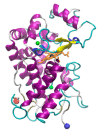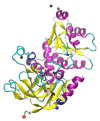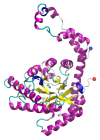Effects of Ionic Liquids on Metalloproteins
- PMID: 33478102
- PMCID: PMC7835893
- DOI: 10.3390/molecules26020514
Effects of Ionic Liquids on Metalloproteins
Abstract
In the past decade, innovative protein therapies and bio-similar industries have grown rapidly. Additionally, ionic liquids (ILs) have been an area of great interest and rapid development in industrial processes over a similar timeline. Therefore, there is a pressing need to understand the structure and function of proteins in novel environments with ILs. Understanding the short-term and long-term stability of protein molecules in IL formulations will be key to using ILs for protein technologies. Similarly, ILs have been investigated as part of therapeutic delivery systems and implicated in numerous studies in which ILs impact the activity and/or stability of protein molecules. Notably, many of the proteins used in industrial applications are involved in redox chemistry, and thus often contain metal ions or metal-associated cofactors. In this review article, we focus on the current understanding of protein structure-function relationship in the presence of ILs, specifically focusing on the effect of ILs on metal containing proteins.
Keywords: ionic liquids; metalloproteins; protein denaturation; protein folding.
Conflict of interest statement
The authors declare no conflict of interest.
Figures






References
-
- Branden C.I., Tooze J. Introduction to Protein Structure. Garland Science; New York, NY, USA: 2012.
-
- Lesk A.M. Introduction to Protein Architecture: The Structural Biology of Proteins. Oxford University Press; New York, NY, USA: 2001.
-
- Lesk A. Introduction to Protein Science: Architecture, Function, and Genomics. Oxford University Press; New York, NY, USA: 2010.
Publication types
MeSH terms
Substances
Grants and funding
LinkOut - more resources
Full Text Sources
Other Literature Sources
Miscellaneous

